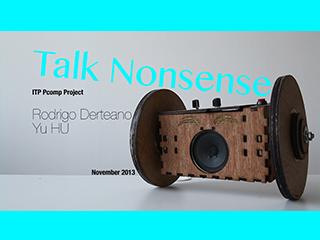Rodrigo Derteano
Yu Hu
Talk Nonsense
Play with recorded voice to create rhythmic, cool, nonsensical sound jams.
https://vimeo.com/80736884

Classes
Introduction to Physical Computing
Introduction to Physical Computing
"Talking nonsense" is a sound toy for playing with live recorded voice. A recorded sentence gets decomposed into rhythmic loops and patterns by turning wheels and knobs.
How does it work? 1. Open the box to record a new sound. Close it to stop recording. 2. Push the button on the top to start playback. 3. Move the box on its wheels and use the two knobs at the same time, and you can create various interesting rhythms and sounds from only one sentence.
When moving the box forward a bit after recording a sentence like "I am recording", it just repeats the sentence. Moving it back carefully may give out something like "recording am I". Playing around a given point will loop the sound at that point: "am am am am". Moving it back and forth, changing the volume and loop length with the knobs at the same time, is like playing with your voice like a DJ.
Background
Hardware sampling techniques
remix / dj culture
sound toys / art objects
Audience
People interested music and sound.
Musicians (amateur and professional)
People interested in design, art objects.
Children
User Scenario
"Talking nonsense" is a sound toy / art object. Ideally it lives on top of any table or surface, waiting for someone to pick it up. When the user picks it up, he/she records a sentence or sounds by talking into the box and starts playing with it: moving it back and forth, turning the knobs. First he/she will be testing the individual controls, but after a while it becomes a fun and interesting musical interface. Moving the object and using the knobs at the same time makes for a nice set of possibilities that generate interesting sound patterns.
Implementation
Made of:
Ply-wood
Encorder
Voice Shield
Arduino Micro with Headers - 5V 16MHz - (ATmega32u4 - assembled)
Stereo 3.7W Class D Audio Amplifier - MAX98306
Electret Microphone Amplifier
Game plan:
Record sounds and play-back in an interesting way, we want the user enjoy the interactive way and freely control sounds by movement and potentiometers, create various possibilities sounds. Go ahead, have a try and have fun, please.
Conclusion
What did we learn:
- how to take an idea involving physical computing and put it together piece by piece.
- learning from a project every step on the way, being open to change the original idea in face of the resulting experience
How does it work? 1. Open the box to record a new sound. Close it to stop recording. 2. Push the button on the top to start playback. 3. Move the box on its wheels and use the two knobs at the same time, and you can create various interesting rhythms and sounds from only one sentence.
When moving the box forward a bit after recording a sentence like "I am recording", it just repeats the sentence. Moving it back carefully may give out something like "recording am I". Playing around a given point will loop the sound at that point: "am am am am". Moving it back and forth, changing the volume and loop length with the knobs at the same time, is like playing with your voice like a DJ.
Background
Hardware sampling techniques
remix / dj culture
sound toys / art objects
Audience
People interested music and sound.
Musicians (amateur and professional)
People interested in design, art objects.
Children
User Scenario
"Talking nonsense" is a sound toy / art object. Ideally it lives on top of any table or surface, waiting for someone to pick it up. When the user picks it up, he/she records a sentence or sounds by talking into the box and starts playing with it: moving it back and forth, turning the knobs. First he/she will be testing the individual controls, but after a while it becomes a fun and interesting musical interface. Moving the object and using the knobs at the same time makes for a nice set of possibilities that generate interesting sound patterns.
Implementation
Made of:
Ply-wood
Encorder
Voice Shield
Arduino Micro with Headers - 5V 16MHz - (ATmega32u4 - assembled)
Stereo 3.7W Class D Audio Amplifier - MAX98306
Electret Microphone Amplifier
Game plan:
Record sounds and play-back in an interesting way, we want the user enjoy the interactive way and freely control sounds by movement and potentiometers, create various possibilities sounds. Go ahead, have a try and have fun, please.
Conclusion
What did we learn:
- how to take an idea involving physical computing and put it together piece by piece.
- learning from a project every step on the way, being open to change the original idea in face of the resulting experience

